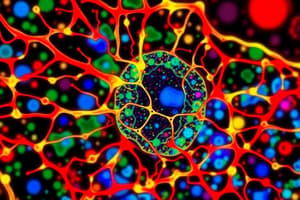Podcast
Questions and Answers
What role does the cytoskeleton play in a cell?
What role does the cytoskeleton play in a cell?
- It enables enzymatic reactions to occur more quickly.
- It regulates the transport of molecules across the cell membrane.
- It provides a framework that gives the cell its shape and enables organelle movement. (correct)
- It produces energy through cellular respiration.
Which of the following accurately distinguishes eukaryotic cells from prokaryotic cells?
Which of the following accurately distinguishes eukaryotic cells from prokaryotic cells?
- Prokaryotic cells lack membrane-bound organelles. (correct)
- Eukaryotic cells are generally smaller than prokaryotic cells.
- Both types of cells contain specialized organelles.
- Eukaryotic cells have a more complex biochemical function.
What is the function of enzymes in cellular biosynthesis?
What is the function of enzymes in cellular biosynthesis?
- They act as catalysts that facilitate and regulate chemical reactions. (correct)
- They serve as the primary energy source for cellular processes.
- They are permanently altered during chemical reactions.
- They break down molecules into simpler forms.
What is the significance of the transformation of small molecules into complex reaction products within a cell?
What is the significance of the transformation of small molecules into complex reaction products within a cell?
During which phase does a cell ingest molecules from its surroundings?
During which phase does a cell ingest molecules from its surroundings?
Which systems in the study of human physiology are primarily responsible for the transformation and excretion of food?
Which systems in the study of human physiology are primarily responsible for the transformation and excretion of food?
What is the primary focus of the endocrine system in human physiology?
What is the primary focus of the endocrine system in human physiology?
Which components are NOT part of the musculoskeletal system in human physiology?
Which components are NOT part of the musculoskeletal system in human physiology?
What defines the primary function of the immune system?
What defines the primary function of the immune system?
Which component is key in the study of the renal/urinary system?
Which component is key in the study of the renal/urinary system?
Flashcards are hidden until you start studying
Study Notes
Cytosol and Cytoskeleton
- Contains a fibrous framework, the cytoskeleton, which provides cell shape and mobility for organelles.
- Houses over 10,000 different molecules essential for cellular biosynthesis, converting small molecules into larger biological macromolecules.
Cell Types: Eukaryotes vs. Prokaryotes
- Eukaryotic cells possess specialized organelles; prokaryotic cells do not and are generally smaller.
- All cells share fundamental biochemistry despite structural differences.
Cell Growth and Division
- Cellular reproduction occurs in two phases: cell growth (ingestion and processing of molecules) and cell division.
- Enzymes act as catalysts, facilitating biochemical transformations without being consumed in the process, enabling complex reaction chains.
Histories of Cellular Discoveries
- 1952: Huxley and Hodgkin discovered ionic mechanisms of nerve impulses.
- 1954: Huxley and Huxley advanced muscle studies, particularly the sliding filament theory.
Major Human Physiological Systems
- Circulatory System: Heart, blood vessels, and blood properties affecting health and disease.
- Digestive/Excretory System: Processes food conversion and waste elimination involving key organs like the liver and pancreas.
- Endocrine System: Hormonal signaling for organismal response; major glands include the pituitary and thyroid.
- Immune System: Comprises white blood cells, thymus, lymphatic systems, antibodies, and cytokines for pathogen defense.
- Integumentary System: Skin, hair, nails, and glands involved in protection and regulation.
- Musculoskeletal System: Skeleton, muscles, ligaments, and bone marrow for muscle movement and blood cell production.
- Nervous System: Brain, spinal cord, peripheral nerves; studies sensations, memory, and movement.
- Renal/Urinary System: Kidneys and associated structures, responsible for waste removal and urine formation.
- Reproductive System: Gonads and sex organs involved in gamete formation and fetal development.
- Respiratory System: Structures for oxygen intake and carbon dioxide expulsion.
Branches of Physiology
- Cell Physiology: Focuses on cell function and interactions.
- Systems Physiology: Mathematical modeling of biological systems and their components' responses.
- Evolutionary Physiology: Studies adaptations and changes over generations, including behavior and physiological variations.
- Defense Physiology: Analyzes physiological changes during stress responses.
- Exercise Physiology: Investigates physical exercise effects on various bodily functions.
Structure and Function of Cells
- Cells are the fundamental unit of life, enclosed by plasma membranes that manage nutrient entry and waste removal.
- Organelles such as the nucleus (contains genetic material), mitochondria (energy transactions), lysosomes (digestion), and the endoplasmic reticulum (molecule synthesis) facilitate cellular processes.
- Plant cells have chloroplasts for photosynthesis, converting CO2 and H2O into carbohydrates.
Cytoskeletal Components
- Microvilli: Increase surface area, commonly found in intestinal cells for absorption.
- Cytoplasm: Fluid matrix containing water, enzymes, and the cytoskeleton, which provides structural support.
- Microtubules: Hollow tubes of tubulin, involved in intracellular transport and mitosis.
- Microfilaments: Actin protein threads, critical for cell motility and transport processes.
- Centrioles: Organize microtubule formation for chromatid separation during cell division.
Nucleus Structure
- Surrounded by a layered membrane roughly 7.5 nm thick, housing genetic material essential for cellular function and reproduction.
Studying That Suits You
Use AI to generate personalized quizzes and flashcards to suit your learning preferences.




